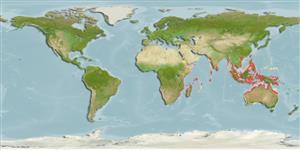Issue
Synonym of Pristis pristis (Linnaeus, 1758) according to Faria et al., 2012 (Ref. 93006:11) and Weigmann, 2016 (Ref. 106604); status confirmed by William White (pers. Comm., Feb 2016).
Environment: milieu / climate zone / depth range / distribution range
生態学
海; 新鮮な水; 汽水性の 底生の; 両側回遊性 (Ref. 51243); 深さの範囲 0 - 10 m (Ref. 27000). Tropical; 22°N - 39°S, 20°E - 154°E
Indo-West Pacific: East Africa to New Guinea, north to the Philippines and Viet Nam, south to Australia. Also Atlantic and eastern Pacific if Pristis perotteti and Pristis zephyreus are synonymized with this species. The original description of Pristis microdon did not give a locality, but most authors have used the name Pristis microdon for the Indo-West Pacific sawfishes of this species group as contrasted from the Atlantic Pristis perotteti and the eastern Pacific Pristis zephyreus.
Length at first maturity / サイズ / 重さ / 年齢
Maturity: Lm 270.0, range 240 - 300 cm
Max length : 700 cm TL オス/雌雄の選別がない; (Ref. 58048); common length : 500 cm TL オス/雌雄の選別がない; (Ref. 2683); 最大公表体重: 600.0 kg (Ref. 3164); 最大記録サイズ: 30 年 (Ref. 9859)
背面の脊椎 (合計) : 0; 肛門の骨: 0. Diagnosis: A heavily-bodied sawfish with a short but massive saw which is broad-based, strongly tapering and with 14-22 very large teeth on each side; space between last 2 saw-teeth on sides less than 2 times space between first 2 teeth (Ref. 5578). Pectoral fins high and angular, 1st dorsal fin mostly in front of pelvic fins, and caudal fin with pronounced lower lobe (Ref. 5578).
Inhabits sandy or muddy bottoms of shallow coastal waters, estuaries, river mouths, and freshwater rivers and lakes. Usually found in turbid channels of large rivers over soft mud bottoms (Ref. 2847, 44894). Adults usually found in estuaries and young ascend into fresh water. Large adults can also be found in fresh water, but are rarely caught (Ref. 12693). Feeds on benthic animals and small schooling species. Ovoviviparous (Ref. 50449). The saw is used for grubbing and attacking prey as well as for defense. The saws sell as tourist souvenirs (Ref. 7248). Occasionally caught by demersal tangle net and trawl fisheries in the Arafura Sea; possibly extinct in parts of the Indo-Pacific; highly susceptible to gill nets. Utilized for its fins and meat (both of very high value), and skin and cartilage (Ref.58048). Attains 4.6 m total length (Ref. 52193).
Life cycle and mating behavior
Maturities | 繁殖 | Spawnings | Egg(s) | Fecundities | 幼生
Ovoviviparous, embryos feed solely on yolk (Ref. 50449). Gestation period about 5 months (Ref. 9859); litter size 1- 13 (Ref. 5578). Probably breeds in freshwater (Ref.58048).
Last, P.R. and J.D. Stevens, 1994. Sharks and rays of Australia. CSIRO, Australia. 513 p. (Ref. 6871)
人間に対する脅威
Traumatogenic (Ref. 4690)
Human uses
水産業: 少数商業の; ゲームフィッシュ: はい
用具
特記事項
XMLをダウンロードして下さい
インターネットの情報源
Estimates based on models
Preferred temperature (Ref.
123201): 24.6 - 29.2, mean 28.5 °C (based on 2653 cells).
Phylogenetic diversity index (Ref.
82804): PD
50 = 0.5234 [Uniqueness, from 0.5 = low to 2.0 = high].
Bayesian length-weight: a=0.00501 (0.00198 - 0.01270), b=3.05 (2.83 - 3.27), in cm total length, based on LWR estimates for this (Sub)family-body shape (Ref.
93245).
栄養段階 (Ref.
69278): 3.9 ±0.61 se; based on food items.
回復力 (Ref.
120179): 非常に低い, 14年以上の倍増期間の最小個体群 (tm=10; tmax=30; Fec=1).
Fishing Vulnerability (Ref.
59153): Very high vulnerability (90 of 100).
Nutrients (Ref.
124155): Calcium = 13.9 [3.0, 64.7] mg/100g; Iron = 0.512 [0.120, 1.459] mg/100g; Protein = 19.4 [17.2, 21.6] %; Omega3 = 0.0888 [, ] g/100g; Selenium = 53.2 [15.0, 189.9] μg/100g; VitaminA = 4.43 [1.44, 13.30] μg/100g; Zinc = 0.681 [0.321, 1.284] mg/100g (wet weight);
